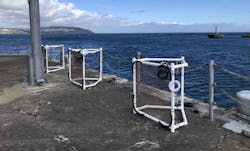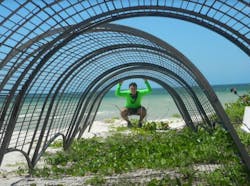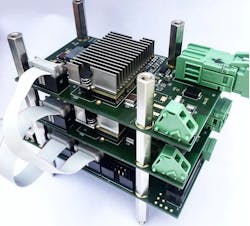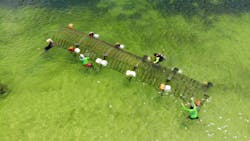Artificial Reefs Built from Sun and Seawater Will Protect the Isle of Man
What you'll learn:
- The protective benefit of artificial reefs.
- The electrolysis technology used to build the reef.
- What will power the reef formation system?
- How control systems will generate data to create a "digital" reef.
The first ever deep-water marina planned for the Irish Sea will be protected against wave damage by an artificial reef built in-situ. It will leverage an electrolytic process that creates a coral-like substrate from minerals abundantly available in seawater.
The project is being undertaken off the shore of Ramsey, Isle of Man, by British-based CCell Renewables, which developed the technology as a cost-effective way to protect fragile coastlines and encourage the growth of robust marine ecosystems. An on-site solar farm will be used to power the nine-month trial in Douglas Harbor, located just south of the proposed site for the Ramsey Marina. It will serve as both a marine habitat and a living barrier against coastal erosion.
Both issues, especially coastal erosion, are a steadily growing concern throughout the world. The effects of coastal erosion are caused by the stronger and more frequent storms and rising sea levels, which many scientists now agree are principally due to climate change.
This test of the technology in the colder waters off the British Isles follows an 18-month trial at the Yucatan village of Telchac, in the Gulf of Mexico, where CCell successfully deployed a 120-meter-long artificial reef (see video below). Despite the fact that its limestone coating is still in process, the structures are already demonstrating their ocean-calming capabilities at a cost of £1000/m, versus the £2k to £5k cost of a shorter-lived concrete breakwater.
Rock from Sun and Seawater
As reported by Electronic Design in January 2020, CCell's reef-building system (originally developed by BioRock Technology) uses the electrolysis of seawater to extract calcium carbonate (limestone) and deposit it on large steel frames that that serve as forms to give the new reef its early structure. Thanks to careful control of the power waveform being applied to the frames, the process grows rock at approximately 2.5 cm (1 in.) per year. At that pace, it takes only five years to build the substrate, rather than the hundreds of years it would take to form naturally.
As with CCell's earlier project in the Gulf of Mexico, the harbor's reef formation system will be powered by renewable energy, in this case, an onshore solar plant. But renewable sources such as solar, wind, and wave power generation, tend to have highly variable outputs that, if unmanaged, will impact the efficiency of the electrolysis process.
To overcome this problem, CCell teamed with Vicor, a power technology company, to create a power-distribution network that could use the widely varying outputs to produce the highly regulated power needed to achieve optimal limestone growth.
This requires the power system to control the voltage potential between the electrodes within a narrow “goldilocks zone” of 1.2 to 4 V to drive a precisely calculated current through seawater. Vicor worked with CCell to apply its Factorized Power Architecture (FPA) to the task. FPA breaks up, or "factorizes," the dc-dc function into two modules—a separate pre-regulator module (PRM) buck-boost regulator that feeds a well-controlled intermediate bus voltage to one or more point-of-load (PoL) conversion devices.
For the Isle of Man project, CCell will use a variant of the original power system it developed in Mexico. The output of the solar power plant feeds a voltage-transformation module (VTM) current multiplier, which is a fixed-ratio (non-regulating) resonant converter with high current density. Working in a tightly integrated manner, the PRM tightly regulates the voltage required for the reef and the VTM handles the downconversion and current delivery to the electrodes.
Smart Reefs
In addition to stimulating reef growth, the project will collect the status information and performance data generated by the system's control systems and feed it to a wireless internet connection, creating what CCell refers to as a "digital reef.” By connecting the reefs to the Internet of Things (IoT), the company will be able to observe the marine environment and take regular measurements from its office in London.
Dr Will Bateman, Founder and CEO of CCell, said, “Our reef technology—a ‘plug-in digital living reef’—will provide the marina with natural protection from erosion and at the same time enhance the quality of the local marine ecosystem. It’s great to be involved in a major project in UK and European waters—our first—and be part of such an exciting development that will boost the Isle of Man’s marine environment and its economy.”
Additional Benefits
CCell’s reef structures will be placed at the base of the marina's breakwater to protect its walls from erosion (scour protection). The structures also have been designed to serve a habitat for existing life and help encourage greater biodiversity. As part of its work, CCell will be testing the integration of used scallop shells within the reef and, in due course, used mussel shells, both by-products from the Island’s fishing industry.
This short video shows how CCell's artificial-reef technology can be used to protect fragile coastlines against erosion.
Around the reefs, and across Ramsey Bay, the project also will partner with the Ocean Conservation Trust in Plymouth on efforts to regenerate the local seagrass meadows. Seagrass not only helps to clean the water, but it’s said to capture 35X more carbon dioxide than the equivalent area of terrestrial forest. Complementing the project's seagrass growth, the habitat created by CCell’s reef is expected to provide a significant bump in the quantities and varieties of fish living in the Isle of Man's waters.
The present plan is to have the first artificial reefs installed during 2024/25. The reef structures themselves have a design lifespan of 40 years, but the living rocks and the thriving ecosystem they’re expected to leave behind should live well beyond that. CCell and its partners are confident that their project will achieve these goals.
Click here to learn more about CCell’s reef-building technology.




